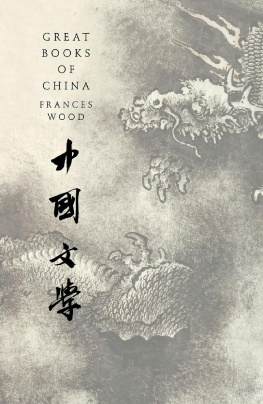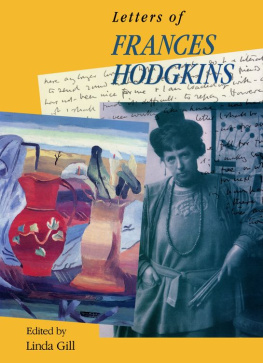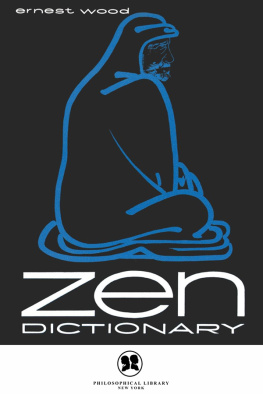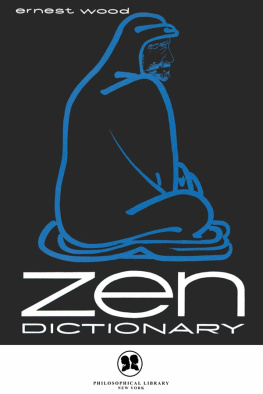Frances Wood - Great Books of China
Here you can read online Frances Wood - Great Books of China full text of the book (entire story) in english for free. Download pdf and epub, get meaning, cover and reviews about this ebook. year: 2017, publisher: HEAD OF ZEUS, genre: Religion. Description of the work, (preface) as well as reviews are available. Best literature library LitArk.com created for fans of good reading and offers a wide selection of genres:
Romance novel
Science fiction
Adventure
Detective
Science
History
Home and family
Prose
Art
Politics
Computer
Non-fiction
Religion
Business
Children
Humor
Choose a favorite category and find really read worthwhile books. Enjoy immersion in the world of imagination, feel the emotions of the characters or learn something new for yourself, make an fascinating discovery.
- Book:Great Books of China
- Author:
- Publisher:HEAD OF ZEUS
- Genre:
- Year:2017
- Rating:3 / 5
- Favourites:Add to favourites
- Your mark:
- 60
- 1
- 2
- 3
- 4
- 5
Great Books of China: summary, description and annotation
We offer to read an annotation, description, summary or preface (depends on what the author of the book "Great Books of China" wrote himself). If you haven't found the necessary information about the book — write in the comments, we will try to find it.
Great Books of China — read online for free the complete book (whole text) full work
Below is the text of the book, divided by pages. System saving the place of the last page read, allows you to conveniently read the book "Great Books of China" online for free, without having to search again every time where you left off. Put a bookmark, and you can go to the page where you finished reading at any time.
Font size:
Interval:
Bookmark:

GREAT BOOKS OF CHINA
Frances Wood
www.headofzeus.com
 |
In Great Books of China , Frances Wood invites readers to explore Chinas rich history and heritage via a sequence of illuminating encounters with sixty-six outstanding works of Chinese literature.
The books chosen reflect the chronological and thematic breadth of Chinas literary tradition; they include the Confucian and Daoist classics (notably the Analects and Classic of the Way and of Virtue ), popular novels and dramas (such as The Water Margin and The Romance of the Western Chamber ), works of poetry, biography, military and political theory, gardening, eroticism and epic travel, as well as modern novels that are little known in the West. Each book is the subject of a concise essay that sets the work firmly in historical and cultural context, profiles its author, and offers a generous complement of evocative citation.
As accessible and engaging as it is penetrating and informative, Great Books of China is a box of unexpected literary delights that opens up the vastness and variety of Chinese culture to the inquisitive reader.
*
Shi jing Author unknown
Yi jing Author unknown
Daode jing L AOZI
Z HUANGZI
Lun yu C ONFUCIUS
Mengzi M ENCIUS
Sunzi bingfa S UN W U
Tongshu Author unknown
Yi li Author unknown
Shi ji S IMA Q IAN
Gu shi shijiu shou Author unknown
Foguo ji F AXIAN
Saddharmapundarika sutra Author unknown
Vajracchedikaprajnaparamita sutra Author unknown
L I B AI
D U F U
L I S HANGYIN
Yingying zhuan Y UAN Z HEN
Dong shi Xi xiang ji zhugongtiao D ONG J IEYUAN
Xi xiang ji W ANG S HIFU
L I Q INGZHAO
Zhao shi guer Attributed to J I J UNXIANG
Sanzi jing Attributed to W ANG Y INGLIN
Ershisi xiao Attributed to G UO J UJING
Shuihu zhuan Attributed to S HI N AIAN or L UO G UANZHONG
Sanguo zhi Attributed to L UO G UANZHONG
Pipa ji G AO M ING
Lu Ban jing Author unknown
Xiyou ji Attributed to W U C HENG EN
Jinpingmei Author unknown
Rou putuan Attributed to L I Y U
Xu Xiake youji X U X IAKE
Hongxuan yinyuan tuji L INQING
Yuan ye J I C HENG
Tiangong kaiwu S ONG Y INGXING
Jieziyuan huazhuan Author unknown; preface by L I Y U
Taohua shan K ONG S HANGREN
Y UAN M EI
Rulin waishi W U J INGZI
Tang shi sanbai shou S UN Z HU
Liaozhai zhiyi P U S ONGLING
Hongloumeng C AO X UEQIN
Fusheng liu ji S HEN F U
Q IU J IN
Lao Can youji L IU E
Gu xiang (in Nahan )
Gushi xinbian L U X UN
Shafei nshi riji D ING L ING
Er Ma
Luotuo xiangzi
Zheng hongqi xia L AO S HE
Jia B A J IN
Ziye M AO D UN
Yige nbing de zizhuan X IE B INGYING
Fengxue ye guiren W U Z UGUANG
Xiao Erhei jiehun Z HAO S HULI
Zhu Yuanzhang zhuan W U H AN
Wei cheng Q IAN Z HONGSHU
Chengnan jiushi L IN H AIYIN
Wode qian ban sheng P UYI
Mao Zhuxi yulu M AO Z EDONG
Bansheng yuan
Si, rong Z HANG A ILING (E ILEEN C HANG )
Yin xianzhang C HEN R UOXI (C HEN J O - HSI )
Ganxiao liu ji Y ANG J IANG
Ren a ren! D AI H OUYING
Chinese characters have been used to distinguish the various types of literature included. Sometimes the name of the author has been used (Confucius, Mencius and Mao Zedong) but generally a single character designates history, travel, fiction, memoir etc.

*
T HE EARLIEST SIGNIFICANT BODY OF Chinese writing is to be found on the oracle bones of the Shang dynasty ( c . 16001046 BCE ). These texts are records of divinations, questions concerning the outcome of such activities as military and hunting expeditions and childbirth; they are not literary but documentary and archival. The shoulder blades of oxen and turtle shells were used for divination by the Shang kings, whose territory centered on the eastern reaches of the Yellow River valley down to the Yangtse. The texts inscribed on the oracle bones were short and to the point, but the characters used were the ancestors of todays Chinese script, made more intelligible to us through the Shuo wen jiezi dictionary (analysis and explanation of characters) of 121 CE . Traditional Chinese historiography traces a line of rulers through from the Shang to the Zhou kings, who came from west of the Shang territories and conquered the Shang in 1046 BCE . Recent archaeological discoveries, at Sanxingdui in Sichuan province, for example, have enriched the picture, demonstrating that there were other, and different, local civilizations flourishing in west and south China at the time, though not recorded in the traditional histories. It is from the Zhou that the first body of literature emerges (including the classics associated with Confucius and the Daoist classics), although the passage of millennia means that surviving texts may have considerably changed from their original state.
Zhou rule, which instituted a system of fiefdoms, collapsed in the fifth century BCE when its territorial control broke down into several distinct warring states. Then, after hundreds of years of fighting, a vast area from north of Beijing to near Guangzhou in the south, and from the eastern seaboard to the western area of todays Sichuan province was united by the ruler of the state of Qin in 221 BCE . The ruler of Qin proclaimed himself emperor (thus he is known as the First Emperor) and moved away from the aristocratic system of rule by fief, replacing it with the beginnings of the bureaucracy, a government staffed by trained officials armed with books containing the legal code and administrative regulations. Though the paramount importance of legal training weakened after the fall of the Qin in 206 BCE , the principle of bureaucratic rule was to continue until the early twentieth century.
The First Emperor unified the state that we now know as China by enforcing several methods of standardization, erasing the differences of the separate warring states by imposing a national standard of weights and measures, coinage and writing system. The form of coinage instituted lasted until the early twentieth century, but the standardization of the script was possibly the most significant element underlying the continuity of Chinese civilization and culture. Over the vast territory of China, then as now, many different dialects (or local languages) are spoken, but the written language is generally common to all, even if the characters might be pronounced differently in different areas. The Chinese script does not represent the sounds of the language today, as it is not a phonetic script but a series of up to 44,000 (the number included in the great Kangxi Dictionary [ Kangxi zidian ] of 1716) different characters. Though many non-sinologists still like to describe them as pictograms, very few of todays characters are simple pictures of things: most are much more complex, made up of phonetic elements, phonetic loans, and combinations of these, now frequently combined so that many words consist of two syllables or two characters.
The Qin dynasty, though hugely significant, was short-lived, barely outlasting its founding emperor. It was overthrown by the Han. The Han dynasty (206 BCE 220 CE ) continued and further developed the bureaucratic system of government and largely maintained the same system of law and punishment that it deplored in the Qin. Han historical writing pioneered the line of moral justification by which each new dynasty wrote the history of the previous regime that it had overthrown. In order to justify this violent act and demonstrate the righteous assumption of the Mandate of Heaven, it was necessary to vilify the preceding dynasty, thus the Han histories condemned everything about the Qin. It was during the Han that the precepts associated with Confucius ( c . 551 c . 479 BCE ) began to be associated with the concepts of moral rule and family worship.
Font size:
Interval:
Bookmark:
Similar books «Great Books of China»
Look at similar books to Great Books of China. We have selected literature similar in name and meaning in the hope of providing readers with more options to find new, interesting, not yet read works.
Discussion, reviews of the book Great Books of China and just readers' own opinions. Leave your comments, write what you think about the work, its meaning or the main characters. Specify what exactly you liked and what you didn't like, and why you think so.








![Wood - Cia Rose Series Box Set [Books 1-3]](/uploads/posts/book/141420/thumbs/wood-cia-rose-series-box-set-books-1-3.jpg)
